The iPhone 5s Review
by Anand Lal Shimpi on September 17, 2013 9:01 PM EST- Posted in
- Smartphones
- Apple
- Mobile
- iPhone
- iPhone 5S
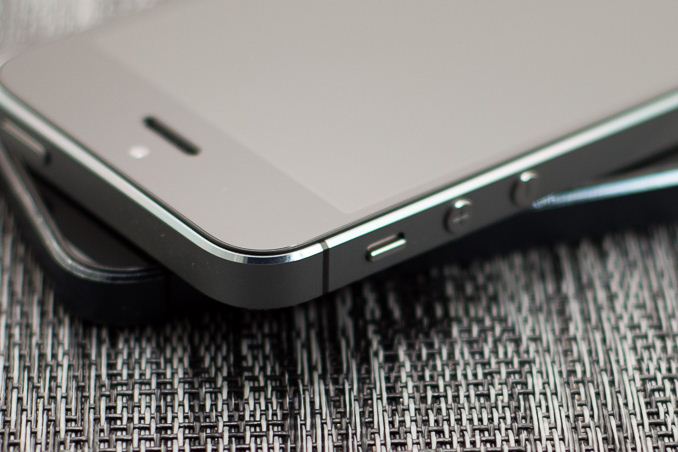
For much of the iPhone's life Apple has enjoyed a first-mover advantage. At the launch of the first iPhone, Steve Jobs expected the device and OS would give it a multi-year head start over the competition. Indeed that's how the market played out. Although Android was met with some early success, it wasn't until well after the launch of the first Android devices that we started seeing broad, mainstream acceptance of the platform. The iPhone bought Apple time, and together with the iPad it brought Apple a tremendous amount of profit over the years. The trick of course is turning a first-mover advantage into an indefinitely dominant market position, a difficult task when you're only making one device a year.
Today we find Apple in a very different position. The iPhone is still loved by a very loyal customer base, but the competition is much stronger than it was back in 2007. The modern smartphone market has also evolved. When Apple introduced the original iPhone with its 3.5" display, Steve called it "giant" on stage. Today even HTC's One mini ships with a 4.3" display.
Last year we saw Apple begin to address the changing landscape with the iPhone 5. The 5 saw Apple moving to a thinner, lighter chassis with much better internals and a significantly larger display. While there is market demand for Apple to do the same again, and move to an even larger display, there are some traditions Apple is sticking to. In this case, it's the tradition of the S-update.
The iPhone 5s continues Apple’s tradition of introducing a performance focused upgrade for the last year of any new chassis design. The first time we encountered an S-update was with the 3GS, which took the iPhone away from its sluggish ARM11 roots and into the world of the Cortex A8.
The next S-upgrade came with the iPhone 4S: Apple’s first smartphone to use a dual-core SoC. At the time I remember debate over whether or not a performance upgrade alone was enough to sell a new device, especially one that didn’t look any different. I’m pretty much never happy with the performance I have, so I eagerly welcomed the new platform. Looking back at the iPhone 4 vs. 4S today, I’d say the investment was probably worth it. In preparation for this review I threw iOS 7 on every iPhone that would support it, dating back to the iPhone 4. In my experience, the 4 is a bit too slow running iOS 7 - the 4S really should be the minimum requirement from a performance standpoint.
That brings us to the iPhone 5s, the third in a list of S-upgrades to the iPhone platform. Like the S-devices that came before it, the iPhone 5s is left in the unfortunate position of not being able to significantly differentiate itself visually from its predecessor. This time around Apple has tried to make things a bit better by offering the 5s in new finishes. While the iPhone 5 launched in silver and black options, the 5s retains silver, replaces black with a new space grey and adds a third, gold finish.
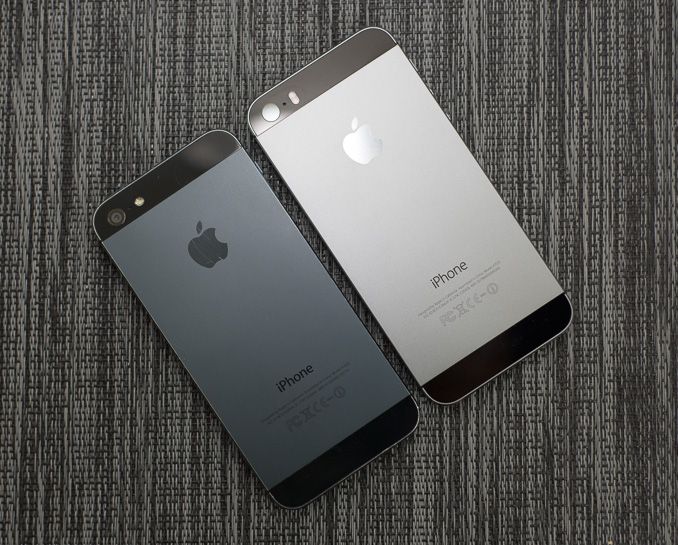
old black iPhone 5 (left) vs. new space grey iPhone 5s (right)
I was sampled a space grey iPhone 5s, which worked out well given my iPhone 5 was black. The new space grey finish is lighter in color (truly a grey rather than a black) and has more prominently colored chamfers. The move to a lighter color is likely to not only offer a little bit of visual differentiation, but also to minimize the appearance of scuffs/scratches on the device. My black iPhone 5 held up reasonably well considering I carry it without a case, but there’s no denying the fact that it looks aged. Interestingly enough, I never really got any scratches on the back of my 5 - it’s the chamfers that took the biggest beating. I have a feeling the new space grey finish will hold up a lot better in that regard as well.
The addition of a gold option is an interesting choice. Brian and I saw the gold iPhone up close at Apple’s Town Hall event and it really doesn’t look bad at all. It’s a very subtle gold finish rather than a gaudy gold brick effect. I think gold is likely the phone I’d opt for simply because it’d be very different than everything else I have, but otherwise space grey is probably the best looking of the three devices to me.
Along with the new finishes come new leather cases to protect the 5s. These cases are designed and sold by Apple, and they are backwards compatible with the iPhone 5 as well. Apple calls them leather cases but I'm not entirely sure if we're talking about real leather here or something synthetic. Either way, the new cases feel great. They've got a very smooth, soft texture to them, and are lined with a suede like material.
The new cases don't add a tremendous amount of bulk to the device either. The cases are available in 5 different colors and retail for $39:
I was sampled a beige case and have been using it non-stop for the past week. I really like the case a lot and it did a great job protecting the 5s over the past week while I was traveling. I took all of the photos of the review device after I returned home from traveling, but thanks to the case the device still looked as good as new. If you're considering one of these cases you might want to opt for a darker color as the edges of my case started to wear from constantly pulling the phone out of my pockets:
If you're fine with the distressed leather look then it's not a concern, but if you're hoping to keep your case pristine you may want to look at other cases. If you want a more affordable & more rugged option, Brian turned me on to the Magpul Field case which should work perfectly with the iPhone 5s.
Since the 5s is an S-upgrade, the chassis remains unchanged compared to the iPhone 5. The 5s’ dimensions are identical to that of the iPhone 5, down to the last millimeter of size and gram of weight. Construction, build quality and in-hand feel continue to be excellent for the iPhone 5s. Despite the diet the iPhone went on last year, the 5/5s chassis is still substantial enough to feel like a quality product. I remember criticisms of the iPhone 5 at launch, saying that it felt too light. Now going back and holding an iPhone 4S, it feels like the very opposite is true - the 4S was too heavy
The iPhone 5s design remains one of the most compact flagship smartphones available. The move to a 4-inch display last year was very necessary, but some will undoubtedly be disappointed by the lack of any further progress on the screen dimension front. A larger display obviously wasn’t in the cards this generation, but I have a strong suspicion Apple has already reconsidered its position on building an even larger iPhone. Part of the problem is the iPhone’s usable display area is very much governed by the physical home button and large earpiece/camera area at the top of the device. Building a larger iPhone that isn’t unwieldy likely requires revisiting both of these design decisions. It’s just too tall of an order for a refresh on the same chassis.
Brian often talks about smartphone size very much being a personal preference, and for many the iPhone 5 continues to be a good target. If you fall into that category, the 5s obviously won’t disappoint. Personally, I would’ve appreciated something a bit larger that made better use of the front facing real estate. The 5s’ width is almost perfect for my hands. I could deal with the device being a little larger, with the ideal size for me landing somewhere between the iPhone 5 and the Moto X.
It remains to be seen the impact display size has on iPhone sales. Anecdotally I know a number of die hard iPhone users who simply want a larger display and are willing to consider Android as a result. I still believe that users don’t really cross shop between Android and iOS, but if Apple doesn’t offer a larger display option soon then I believe it will lose some users not because of cross shopping, but out of frustration.
As a refreshed design, the iPhone 5s carries over all of the innovations we saw in the 5 last year. The iPhone 5s features the same Lightning connector that debuted on the iPhone 5, and has since been extended to the iPad lineup as well as the new iPods.
As with all other S-upgrades, the biggest changes to the iPhone 5s are beneath the aluminum and glass exterior. The 5s’ flagship feature? Apple’s new A7 SoC. The A7 is the world's first 64-bit smartphone SoC, and the first 64-bit mobile SoC shipping in a product (Intel’s Bay Trail is 64-bit but it won’t ship as such, and has yet to ship regardless). In addition to the new 64-bit SoC Apple upgraded both cameras in the iPhone 5s and added a brand new fingerprint sensor called Touch ID. Of course the iPhone 5s is one of the first new iPhones to ship with iOS 7 from the factory.
| Apple iPhone 5 | Apple iPhone 5c | Apple iPhone 5s | |
| SoC | Apple A6 | Apple A6 | Apple A7 |
| Display | 4-inch 1136 x 640 LCD sRGB coverage with in-cell touch | ||
| RAM | 1GB LPDDR2 | 1GB LPDDR3 | |
| WiFi | 2.4/5GHz 802.11a/b/g/n, BT 4.0 | ||
| Storage | 16GB/32GB/64GB | 16GB/32GB | 16GB/32GB/64GB |
| I/O | Lightning connector, 3.5mm headphone | ||
| Current OS | iOS 7 | ||
| Battery | 1440 mAh, 3.8V, 5.45 Whr | 1507 mAh, 3.8V, 5.73 Whr | 1570 mAh, 3.8V, 5.96 Whr |
| Size / Mass | 123.8 x 58.6 x 7.6 mm, 112 grams | 124.4 x 59.2 x 8.97 mm, 132 grams | 123.8 x 58.6 x 7.6 mm, 112 grams |
| Camera |
8MP iSight with 1.4µm pixels Rear Facing 1.2MP with 1.75µm pixels Front Facing |
8MP iSight with 1.4µm pixels Rear Facing 1.2MP with 1.9µm pixels Front Facing |
8MP iSight with 1.5µm pixels Rear Facing + True Tone Flash 1.2MP with 1.9µm pixels Front Facing |
| Price | $199 (16GB), $299 (32GB), $399 (64GB) on 2 year contract | $99 (16GB), $199 (32GB) on 2 year contract | $199 (16GB), $299 (32GB), $399 (64GB) on 2 year contract |
The iPhone 5s also breaks with tradition in a couple of ways. The 5s is the first iPhone in recent history to not be offered up for pre-order. Apple expects demand for the iPhone 5s to severely outstrip supply, and as a result won't be accepting pre-orders on the 5s.
The other big change is what happens to the previous generation iPhone. In the past, Apple would discount the previous generation iPhone by $100 on-contract and continue to sell those devices at low capacity points. A two-generation old iPhone was often offered for free on-contract as well. This time, the iPhone 5s replaces the iPhone 5 at the high end, but the iPhone 5 ceases production. Instead, the 5 is replaced with a cost reduced version (the iPhone 5c). As the glass & aluminum iPhone 5/5s chassis likely doesn't scale well in price, coming up with a new polycarbonate design for slightly lower price points makes sense. I have written a separate piece on the iPhone 5c as I have more than enough to talk about with the iPhone 5s in this review.
I'll start with the big ticket item: Apple's 64-bit A7 SoC.


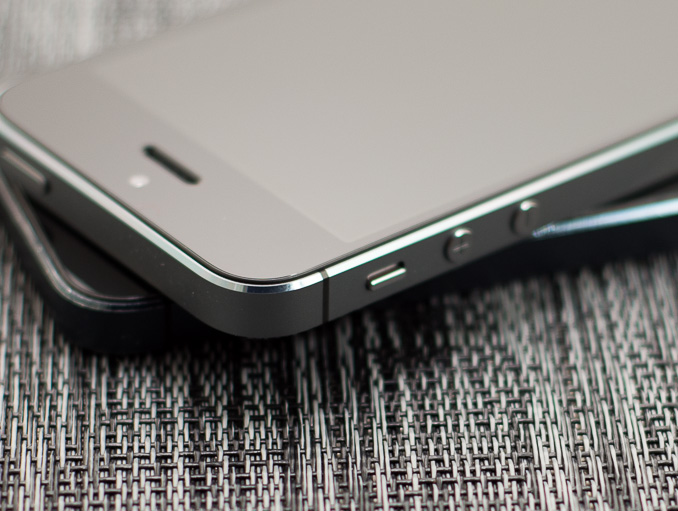
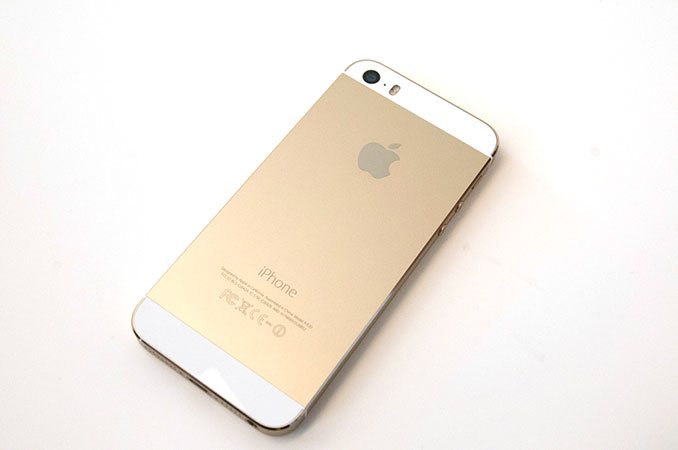
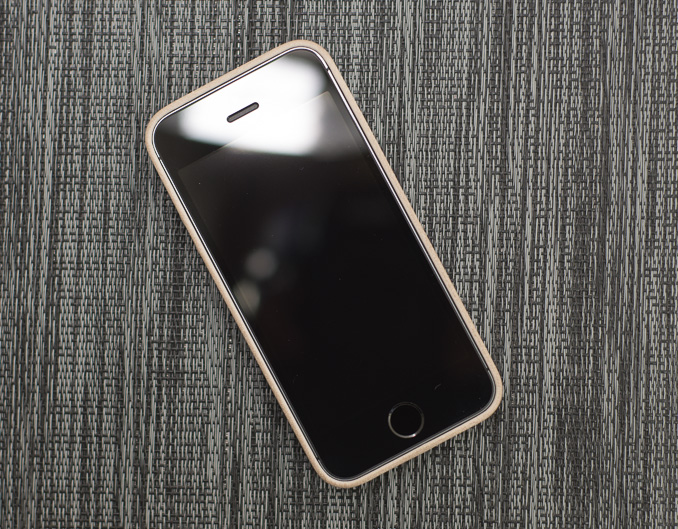
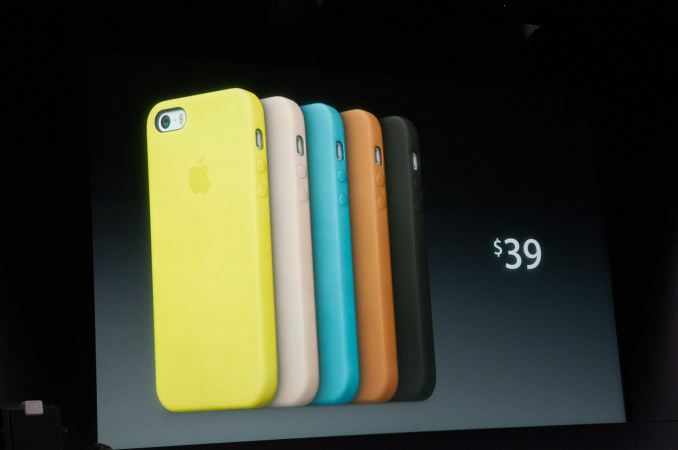
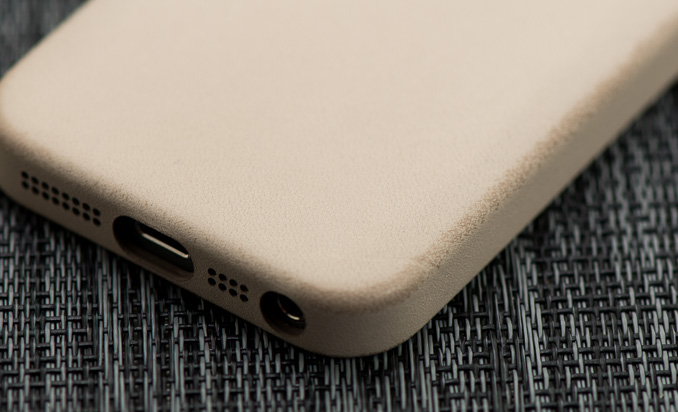
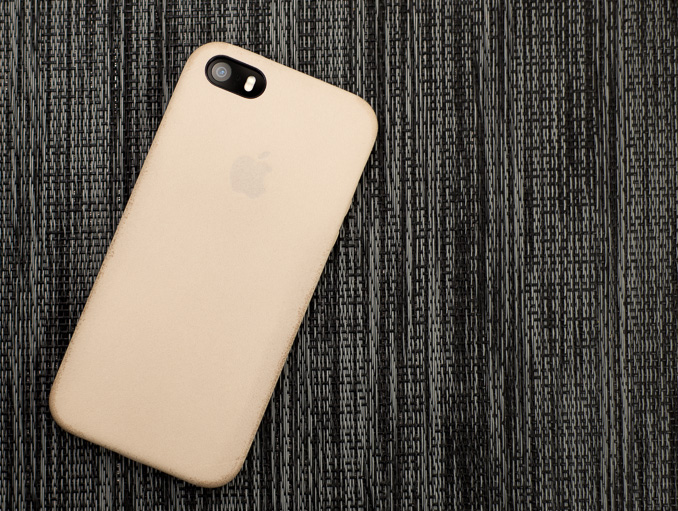








464 Comments
View All Comments
Wilco1 - Wednesday, September 18, 2013 - link
If all you can do is name calling then you clearly haven't got a clue or any evidence to prove your point. Either come up with real evidence or leave the debate to the experts. Do you even understand what IPC means?For example in your link a low clocked Jaguar is keeping up with a much higher clocked Bay Trail (yes it boosts to 2.4GHz during the benchmark run), so the obvious conclusion is that Jaguar has far higher IPC than Bay Trail. For example Jaguar has 28% higher IPC than BT in the 7-zip test. Just like I said.
Now show me a single benchmark where BT gets better IPC than Jaguar. Put up or shut up.
zeo - Wednesday, September 18, 2013 - link
The point that BT Beats Jaguar, especially at performance per watt, clearly proved the point given!And insisting as you are on your original assessment is a characteristic of acting like a Troll... So you're not going to convince anyone by simply insisting on being right... especially when we can point to Anandtech pointing out multiple benchmarks in this article that showed the Kabini performing lower than bother BT and the A7!
So either learn to read what these reviews actually post or accept getting labeled a Troll... either way, you're not winning this argument!
Wilco1 - Wednesday, September 18, 2013 - link
No, Bob's claim was that Bay Trail was faster clock for clock than Jaguar, when the link he gave to prove it clearly showed that is false. BT may well beat Jaguar on perf/watt, but that's not at all what we were discussing.So next time try to understand what people are discussing before jumping in and calling people a Troll. And yes I stand by my characterization of various microarchitectures, precisely because it's based on actual benchmark results.
Bob Todd - Wednesday, September 18, 2013 - link
IPC as a comparison point made a lot of sense when we were arguing about which 130 watt desktop processor had the better architecture. It seems largely irrelevant for mobile where we care about performance per watt. Your argument is continually that the ARM/AMD designs are 'faster' based on Geekbench. If Jaguar has a 28% higher IPC than Bay Trail, do you honestly think it matters if Bay Trail is still the faster chip @ 1/3 (or less) of the power requirements? If someone came up with a crazy design that needed 5x the clocks to have a 2x performance advantage of their competitor, but did so with half the power budget, they'd still be racking up design wins (assuming parity for all other aspects like price). That's a two way street. If ARM designs a desktop/server focused chip that needs higher clocks than Intel to reach performance parity or be faster than Haswell, but does so with significantly less power it's still a huge win for them.Wilco1 - Wednesday, September 18, 2013 - link
IPC matters as you can compare different microarchitectures and make predictions on performance at different clock speeds. I'm sure you know many CPUs come in a confusing variation of clockspeeds (and even different base/turbo frequencies for Intel parts), but the underlying microarchitecture always remains the same. You can't make claims like "Bay Trail is faster than Jaguar" when such a claim would only valid at very specific frequencies. However we can say that Jaguar has better IPC than BT and that will remain true irrespectively of the frequency. So that is the purpose of the list of microarchitectures I posted.I was originally talking about the performance of Apple A7 and Bay Trail in Geekbench. You may not like Geekbench, but it represents close to actual CPU performance (not rubbish JavaScript, tuned benchmarks, cheating - remember AnTuTu? - or unfair compiler tricks).
Now you're right that besides absolute performance, perf/W is also important. Unfortunately there is almost no detailed info on power consumption, let alone energy to do a certain task for various CPUs. While TDP (in the rare cases it is known!) can give some indication, different feature sets, methodologies, "dial-a-TDP" and turbo features makes them hard to compare. What we can say in general is that high-frequency designs tend to be less efficient and use more power than lower frequency, higher IPC designs. In that sense I would not be surprised if the A7 also shows a very good perf/Watt. How it compares with BT is not clear until BT phones appear.
Bob Todd - Wednesday, September 18, 2013 - link
Your point about benchmarks is actually what surprises me the most nowadays. The biggest thing every in-depth review of a new ARM design brings to light is how freaking piss poor the state of mobile benchmarking is from a software standpoint. I didn't expect magic by the time we got to A9 designs, but it's a little ridiculous that we're still in a state of infancy for mobile benchmarking tools over half a decade after the market really started heating up.Bob Todd - Wednesday, September 18, 2013 - link
And by "ARM design" I mean both their cores or others building to their ISA.Wilco1 - Thursday, September 19, 2013 - link
Yes, mobile benchmarking is an absolute disgrace. And that's why I'm always pointing out how screwed up Anand's benchmarking is - I'm hoping he'll understand one day. How anyone can conclude anything from JS benchmarks is a total mystery to me. Anand might as well just show AnTuTu results and be done with it, that may actually be more accurate!Mobile benchmarks like EEMBC, CoreMark etc are far worse than the benchmarks they try to replace (eg. Dhrystone). And SPEC is useless as well. Ignoring the fact it is really a server benchmark, the main issue is that it ended up being a compiler trick contest than a fair CPU benchmark. Of course Geekbench isn't perfect either, but at the moment it's the best and fairest CPU bench: because it uses precompiled binaries you can't use compiler tricks to pretend your CPU is faster.
akdj - Thursday, September 19, 2013 - link
SO.....what is it the 'crew' is supposed to 'do'? NOT provide ANY benchmarks? Anand and team are utilizing the benchmarks available right now. They're not building the software to bench these devices...they're reviewing them...with the tools available, currently, NOW---on the market. If you're so interested in better mobile benchmarking (still in it's infancy---it's only really been 5 years since we've had multiple devices to even test), why not pursue and build your own benchmarking software? Seems like it may be a lucrative project. Sounds like you know a bit about CPU/GPU and SoC architecture---put something together. Sunspider is ubiquitous, used on any and all platforms from desktops to laptops---tablets to phones, people 'get it'. As well, GeekBench is re-inventing their benchmarking software---as well, the Google Octane tests are fairly new...and many of the folks using these devices ARE interested in how fast their browser populates, how quick a single core is---speed of apps opening and launching, opening a PDF, FPS playing games, et al.Again---if you're not 'happy' with how Anand is reviewing gear (the best on the web IMHO), open your own site---build your own tools, and lets see how things turn out for ya!
Give credit where credit is due....I'd much rather see the way Anand is approaching reviews in the mobile sector than a 1500 word essay without benchmarking results because current "mobile benchmarking is an absolute disgrace"
YMMV as always
J
PS---Thanks for the review guys....again, GREAT Job!
Bob Todd - Thursday, September 19, 2013 - link
Umm...I think you missed my point. I love the reviews here. That doesn't change the fact that mobile benchmarking software sucks compared to what we have available on the desktop. That isn't a slam against this site or any of the reviewers, and I fully expect them to use the (relatively crappy) software tools that are available. And they've even gone above and beyond and written some tools themselves to test specific performance aspects. I'm just surprised that with mobile being the fastest growing market, nobody has really stepped up to the plate to offer a good holistic benchmarking suite to measure cpu/gpu/memory/io performance across at least iOS/Android. And no, I don't expect anyone at Anandtech to write or pay someone to write such a tool.